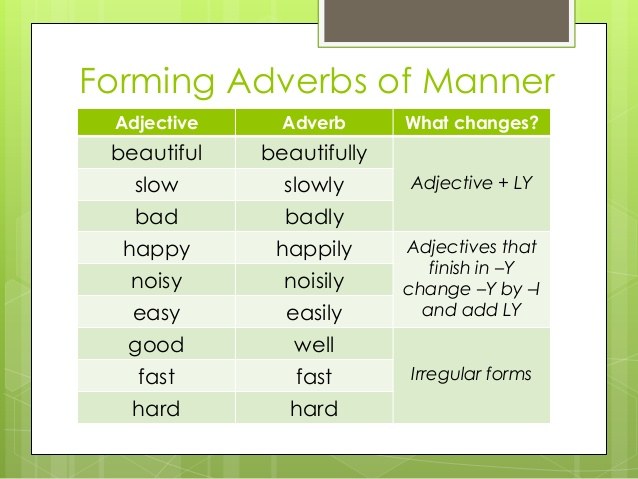1.- FORM
They are formed by adding the suffix –ly to the adjective.
Example: careful- carefully
low- slowly
quiet- quietly
polite- politely
false- falsely
If the adjective ends in –y, it changes into i and adds –ly.
Ex: happy- happily
easy- easily
noisy- noisily
The adjectives friendly, lonely, lovely end in –y. If you want to use the adverb, you must use the expression: in a friendly way, in a lonely way, in a lovely
way.
Ex: She is lovely.
She treats me in a lovely way.
Some adverbs don´t add the suffix –ly to the adjective, they are irregular.
Adjective Adverb
Fast fast
Hard hard
Late late
Good well
Right right
Straight straight
Ex: His work is very hard (adjective)
He works very hard (adverb)
· hardly= apenas
He is a really good actor.( adjective)
He acts really well. (adverb)
The train was late. (adjective)
I got up late.(adverb)
🙋 lately= últimamente
2.- POSITION.
These adverbs are usually placed after the main verb and the object:
Ex: She spoke to me rudely. They arrived late.
Or before an adjective:
Ex: It´s a reasonably cheap restaurant. Oh, I´m terribly sorry.
An adverb of manner cannot be put between a verb and its direct object. The adverb must be placed either before the verb or at the end of the clause.
- She closed softly the door behind her.
However, if the object is long then we normally place the adverb before the verb:
- He angrily denied that he attempted to kill his wife. (the object is underlined)
- She carefully planned the last few days of her stay in London.
VERB + PREPOSITION + OBJECT
Many verbs in English are followed by certain prepositions - some are followed by only one preposition (insist (up)on, accuse of, attend to etc.), while others can be followed by several prepositions (listen to/in on/, look at/for/into/on etc.).
In a construction verb + preposition + object we can place the adverb either after the object or before the preposition:
- I listened to her story carefully. (V + prep. + O + A) or
- I listened carefully to her story. (V + A + prep. + O)
- He replied to my letter quickly.
- He replied quickly to my letter.
- I listened carefully to her story about the adventures in Africa. (the object is underlined)
- He replied quickly to my letter I sent him in a fit of anger
PRACTICE:
Determine the best word order for the adverb of manner.
- Select your response from the list.
- Compare your response to the feedback by clicking the "Check"

No comments:
Post a Comment
Note: only a member of this blog may post a comment.